
Here at IFLScience, we like to cover some of society’s most pressing questions about science. Should death be taught in schools? What do ultra-processed foods mean for our health? And on today’s agenda, perhaps the most important question of them all: what causes an “innie” or an “outie” belly button?
What is a belly button?
Before we get into the ins and outs of innies and outies, it’s important to know what a belly button actually is. The fancy clinical name for a belly button is the umbilicus, which is a handy reminder that it’s the point where the umbilical cord used to be, connecting a developing fetus with the placenta.
After birth, the umbilical cord isn’t needed anymore, so typically it’s cut and clamped, leaving a little stump that eventually dries up and falls off. The belly button is the scar that’s left after this process.
The formation of innies and outies
Some people believe whether you have an innie or an outie belly button depends on how the umbilical cord is cut or where the clamp is placed – but that isn’t the case. It comes down to how the area heals and the scar forms, which depends on the individual. However, some medical conditions – primarily umbilical hernias and granulomas – can be mistaken for an outie belly button.
For a regular outie belly button, there’s nothing to worry about, though they’re certainly the rarer of the two types – an estimated 90 percent of people have an innie belly button, whereas only the remaining 10 percent are left with an outie. Even within the innie and outie categories, there can be various subtypes, relating to features like shape, orientation, and depth.
If you happen to be the proud owner of an innie, while you’re (hopefully) clearing out any fluff that might have accumulated up in there (it happens to the best of us), you might also be inadvertently digging out a wealth of bacteria. A 2012 study that involved swabbing people’s navels for science found over 2,300 different species of bacteria in just 60 belly buttons. Some people have even used belly button bacteria to make cheese.
Belly buttons can sometimes change
Although for the vast majority of people, their belly button will not change, there are a couple of reasons why some people’s navels might change appearance. The first is what’s known as an umbilicoplasty, which is a cosmetic surgery to change the size and/or shape of the belly button.
The second is medical conditions that put extra pressure on the area, forcing an otherwise innie belly button into an outie. The most common of these is pregnancy, where the growing fetus is the one putting the pressure on an innie to put itself out there. This can lead an innie to “pop” at around 26 weeks gestation, though it usually goes back to its normal introverted self after the pregnancy ends.
Whatever kind of belly button you have, it’s perfectly normal. Just please, for the love of all that’s good, make sure you clean all the nooks and crannies.
Source Link: Why Do We Have An Innie Or An Outie Belly Button?